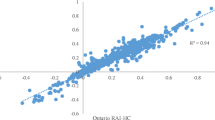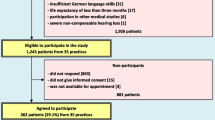Abstract
Background and aims: The MDS inter-RAI Acute Care is a comprehensive geriatric assessment tool for hospitalized older persons. The aim was to examine its validity based on test content by use in daily clinical practice. Methods: Clinical staff of multiple disciplines assessed 256 older persons (83.2±5.2 years; 60% female) in a cross-sectional multicenter study in nine acute hospitals. Test content was empirically tested by frequency distribution of clinical deficits, missing, and invalid data. Item relevance was quantified by the content validity index (CVI) and modified kappa statistics (κ*) based on assessors’ judgment. Results: Clinical deficits exceeded 30% in the majority of items (67%) across all assessment periods. Mean missing data for premorbid, admission, day-14 and discharge assessments were 9.7%, 5.3%, 29.3% and 13.7%, respectively. Invalid scores ranged from 3.9% to 26.7%. Of the 98 items, 82 had excellent CVI (≥0.78). Item relevance was excellent for 82 (κ*≥0.75), good for 9 (0.60≤κ*=0.74) and fair for 3 items (0.40=≤κ*<0.60). Item revision may optimize clinical relevance: removing 4 items with poor relevance would increase the overall CVI from 0.89 to 0.91, meeting the standard of excellent content validity (CVIaverage≥0.90). Conclusions: Although the frequency distribution provides evidence that item selection of the interRAI Acute Care is appropriate for the targeted population, its use in a clinical context reveals a substantial number of missing and invalid data. To improve validity, training should pay specific attention to items with low compliance and invalid records. Software applications should also be designed to improve data quality.
Similar content being viewed by others
References
Baztan JJ, Suarez-Garcia FM, Lopez-Arrieta J, Rodriguez-Manas L, Rodriguez-Artalejo F. Effectiveness of acute geriatric units on functional decline, living at home, and case fatality among older patients admitted to hospital for acute medical disorders: meta-analysis. BMJ 2009; 338: b50.
Van Craen K, Braes T, Wellens N et al. The effectiveness of inpatient geriatric evaluation and management units: a systematic review and meta-analysis. J Am Geriatr Soc 2010; 58: 83–92.
Gray LC, Berg K, Fries BE et al. Sharing clinical information across care settings: the birth of an integrated assessment system. BMC Health Serv Res 2009; 9: 71.
Carpenter GI, Teare GF, Steel K et al. A new assessment for elders admitted to acute care: reliability of the MDS-AC. Aging Clin Exp Res 2001; 13: 316–30.
interRAI, Available at http://www.interrai.org. Accessed August 2010.
Bernabei R, Landi F, Onder G, Liperoti R, Gambassi G. Second and third generation assessment instruments: the birth of standardization in geriatric care. J Gerontol A Biol Sci Med Sci 2008; 63: 308–13.
Hirdes JP, Smith TF, Rabinowitz T et al. The resident assessment instrument-mental health (RAI-MH): Inter-rater reliability and convergent validity. J Behav Health Serv Res 2003; 29: 419–32.
Gray LC, Bernabei R, Berg K et al. Standardizing assessment of elderly people in acute care: the interRAI Acute Care instrument. J Am Geriatr Soc 2008; 56: 536–41.
Büla CJ, Wietlisbach V. Use of the Cognitive Performance Scale (CPS) to detect cognitive impairment in the acute care setting: concurrent and predictive validity. Brain Res Bull 2009: 80: 173–8.
Wellens NIH, Milisen K, Flamaing J, Moons P. Methods to assess the validity of the interRAI Acute Care: a framework to guide clinimetric testing. J Eval Clin Pract 2012; 18: 296–306.
American Educational Research Association, American Psychological Association, National Council on Measurement in Education, Joint Committee on Standards for Educational and Psychological Testing. Standards for educational and psychological testing. Washington, DC: American Educational Research Association, 1999.
Goodwin LD. The meaning of validity in the new Standards For Educational and Psychological Testing: implications for measurement courses. Meas Eval Counsel Devel 2003; 36: 181–91.
Goodwin LD. Changing conceptions of measurement validity: an update on the new standards. J Nurs Educ 2002; 41: 100–6.
Gray L, Berg K, Bernabei R et al. Training manual and resource guide InterRAI Acute Care: guide for use of the interRAI AC assessment form (version 09). InterRAI, 2006
Lynn MR. Determination and quantification of content validity. Nurs Res 1986; 35: 382–5.
Devon HA, Block ME, Moyle-Wright P et al. A psychometric toolbox for testing validity and reliability. J Nurs Scholarsh 2007; 39: 155–64.
Polit DF, Beck CT. The content validity index: are you sure you know what’s being reported? Critique and recommendations. Res Nurs Health 2006; 29: 489–97.
Polit DF, Beck CT, Owen SV. Is the CVI an acceptable indicator of content validity? Appraisal and recommendations. Res Nurs Health 2007; 30: 459–67.
Waltz CF, Strickland O, Lenz ER, Waltz CF. Measurement in nursing and health research, 3rd ed. New York: Springer Publishing Co., 2005.
Cicchetti DV, Sparrow SA. Developing criteria for establishing interrater reliability of specific items: applications to assessment of adaptive behavior. Am J Ment Defic 1981; 86: 127–37.
Fleiss JL. Statistical methods for rates and proportions, 2nd edn. New York, Chichester, Brisbane: John Wiley & Son, 1981.
Cwinn MA, Forster AJ, Cwinn AA, Hebert G, Calder L, Stiell IG. Prevalence of information gaps for seniors transferred from nursing homes to the emergency department. CJEM 2009; 11: 462–71.
Stiell A, Forster AJ, Stiell IG, van Walraven C. Prevalence of information gaps in the emergency department and the effect on patient outcomes. CMAJ 2003; 169: 1023–8.
Gaddis GM. Elder care transfer forms. Acad Emerg Med 2005; 12: 160–1.
Cornette P, Swine C, Malhomme B, Gillet JB, Meert P, D’Hoore W. Early evaluation of the risk of functional decline following hospitalization of older patients: development of a predictive tool. Eur J Public Health 2006; 16: 203–8.
Hirsch CH, Sommers L, Olsen A, Mullen L, Winograd CH. The natural history of functional morbidity in hospitalized older patients. J Am Geriatr Soc 1990; 38: 1296–303.
Abellan van Kan G, Rolland Y, Andrieu S et al. Gait speed at usual pace as a predictor of adverse outcomes in community-dwelling older people: an International Academy on Nutrition and Aging (IANA) Task Force. J Nutr Health Aging 2009; 13: 881–9.
Purser JL, Weinberger M, Cohen HJ et al. Walking speed predicts health status and hospital costs for frail elderly male veterans. J Rehabil Res Dev 2005; 42: 535–46.
Rubenstein LZ, Schairer C, Wieland GD, Kane R. Systematic biases in functional status assessment of elderly adults: effects of different data sources. J Gerontol 1984; 39: 686–91.
Wellens N, Van Lancker A, Flamaing J et al. Interrater reliability of the interRAI Acute Care. Arch Gerontol Geriatr 2011 Aug 19 (Epub ahead of print) doi: 10.1016/j.archger.2011.07.005.
Wellens N, Flamaing J, Tournoy J et al. Convergent validity of the Cognitive Performance Scale of the interRAI Acute Care and the Mini-Mental State Examination. Am J Geriatr Psychiatry 2012 (In Press).
Wellens N, Milisen K, Flamaing J et al. Methods to assess the reliability of the interRAI Acute Care: A framework to guide clinimetric testing part II. J Eval Clin Pract 2011 Apr 26 (Epub ahead of print) doi: 10.1111/j.1365-2753.2011.01685.x.
Wellens N, Deschodt M, Flamaing J et al. First-generation versus third-generation comprehensive geriatric assessment instruments in the acute hospital setting: a comparison of the Minimum Geriatric Screening Tools (MGST) and the interRAI Acute Care (interRAI AC). J Nutr Health Aging 2011; 15: 638–44.
Author information
Authors and Affiliations
Corresponding author
Rights and permissions
About this article
Cite this article
Wellens, N.I.H., Deschodt, M., Boonen, S. et al. Validity of the interRAI Acute Care based on test content: a multi-center study. Aging Clin Exp Res 23, 476–486 (2011). https://doi.org/10.1007/BF03325244
Received:
Accepted:
Published:
Issue Date:
DOI: https://doi.org/10.1007/BF03325244




